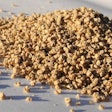Presentations from industry and academia highlighted both the negative and positive effects of dietary NSPs on nutrient utilization and health in pigs and poultry at the Inspire: Non-starch Polysaccharide (NSP) Forum, held at Pitlochry, Scotland.
The April 1 session began with Professors Hank Classen of the University of Saskatchewan and John Patience of Iowa State University outlining the impact of dietary fiber in poultry and swine, respectively. While fiber has the ability to retain water in both species, the level of resulting gut content viscosity differs considerably, and is much more of an issue in poultry.
Patience also explained that up to one third of the energy requirements of mature sows can come from fiber, compared to maybe 3 percent for poultry. Other key findings presented included a clear variation in the impact of NSPs on gut content viscosity with broiler age and the apparent negative effect of excessive NSP breakdown increasing monosaccharide concentrations.
"The issue of how dietary fiber acts within the gut is a very complex one, with numerous interactions happening throughout the digestive process, and affected by the fiber itself, animal factors and the makeup of the diet," explained Classen. "In terms of improving performance and economic return through NSP enzyme use, I think we've done remarkably well considering."
Dr. Knud Erik Bach Knudsen of Aarhus Universitat took the discussion a stage further, explaining some of the detailed differences between conditions in the pig and poultry intestinal tracts that alter interactions with dietary fiber. The impact of NSPs on gut microbiota was investigated by Alimetric's Dr. Juha Apajalahti, who demonstrated the apparent role of butyrate produced from fiber fermentation within the large intestine in improving animal performance.
The challenge facing the industry in getting the fibre balance right was made clear by Professor Ed Moran of Auburn University, who demonstrated the clear link between increased gut viscosity - caused by high levels of soluble long-chain NSPs - and an increased risk of necrotic enteritis. This theme was further developed during the final presentation of the day by AB Vista's Dr. Hadden Graham, who explained not only the history of feed enzyme use and the commercial drivers behind it, but also the often unpredictable nature of animal response to NSP enzymes.
"The market today is dominated by xylanase products, but in most of the research we don't know exactly what was delivered to the animal being investigated," he stated. "Rarely are enzyme levels in the finished feed assayed, and we know large changes can take place during mixing and processing, so it is not surprising we sometimes don't get the results we expect.
"There are clear economic gains to be made, but it is also clear that there is still a lot of work to be done."






